Pt. 2: Taisho Democracy and the Seeds of Capitalist Democracy
Population in 1926: est. 60 million people
After the Meiji era came the Taisho era, which heralded a decade of peace and increased representation, similar to the Gilded Age in the West. As Japan’s economy became enriched from the trade and development that began in the Meiji era, a new class of wealthy business people and thought leaders emerged, in a decade known as the Taisho democracy.
It was a grand era that also jump started Japan’s transition from autocracy to democracy. People started to express political opinions, and several movements were launched that brought wide changes and planted the seeds of democratic thought. Political movements including demands for universal suffrage and a free press stemmed from the rising power of capitalists and finance experts. This also led to a rise of a new class of highly educated, knowledgeable, and worldly people who led many of the movements that defined this era.
This movement coincided with rapid population growth. By the end of the Taisho era, the population of Japan almost doubled from the beginning of the Meiji era.


 Parthenon Japan
Parthenon Japan